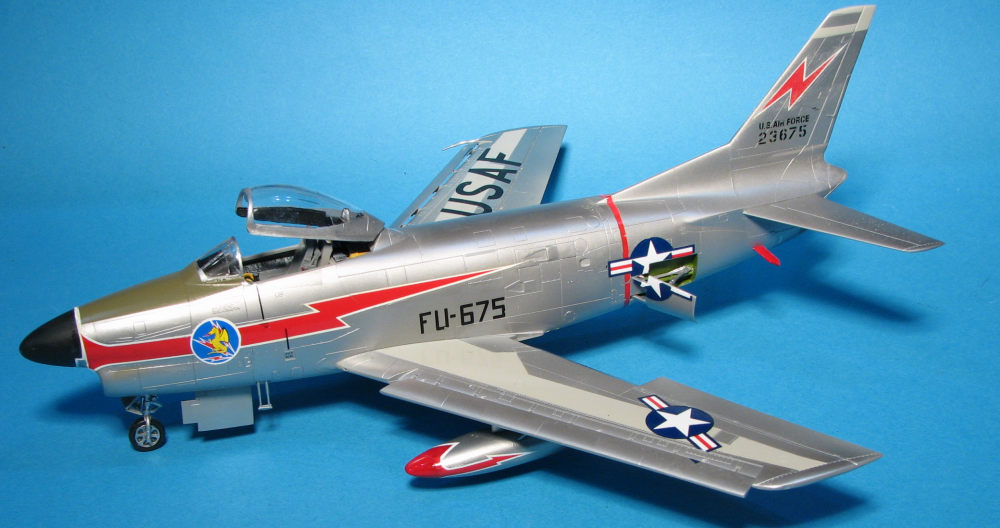
ProModeler 1/48 F-86D 'Sabre Dog'
| KIT #: | 5960 |
| PRICE: | $22.95 SRP at the time |
| DECALS: | Two options |
| REVIEWER: | Scott Van Aken |
| NOTES: | 2001 initial release |

| HISTORY |
The YF-95 was a development of the F-86 Sabre, the first aircraft designed
around the new 2.75-inch (70 mm) "Mighty Mouse" Folding-Fin Aerial
Rocket (FFAR). Begun in March 1949, the unarmed prototype, 50-577, first flew on
22 December 1949, piloted by North American test pilot George Welch and was the
first U.S. Air Force night fighter design with only a single crewman and a
single engine, a J47-GE-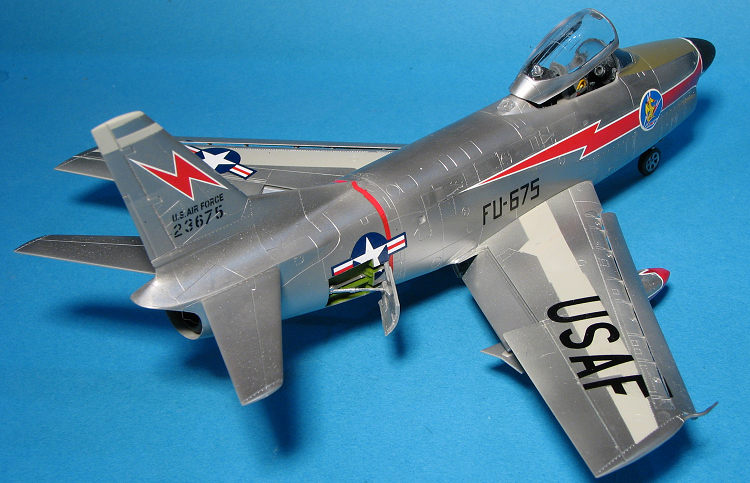 17 with afterburner rated at 5,425 lbf (24.1 kN)
static thrust. Gun armament was eliminated in favor of a retractable
under-fuselage tray carrying 24 unguided Mk. 4 rockets, then considered a more
effective weapon against enemy bombers than a barrage of cannon fire. A second
prototype, 50-578, was also built, but the YF-95 nomenclature was short-lived as
the design was subsequently redesignated YF-86D.
17 with afterburner rated at 5,425 lbf (24.1 kN)
static thrust. Gun armament was eliminated in favor of a retractable
under-fuselage tray carrying 24 unguided Mk. 4 rockets, then considered a more
effective weapon against enemy bombers than a barrage of cannon fire. A second
prototype, 50-578, was also built, but the YF-95 nomenclature was short-lived as
the design was subsequently redesignated YF-86D.
The fuselage was wider and the airframe length increased to 40 ft 4 in (12.3 m), with a clamshell canopy, enlarged tail surfaces and AN/APG-36 all-weather radar fitted in a radome in the nose, above the intake. Later models of the F-86D received an uprated J-47-GE-33 engine rated at 5,550 lbf (24.7 kN) (from the F-86D-45 production blocks onward). A total of 2,504 D-models were built. .AN/APG-36 all-weather radar.
Despite being rushed into service to counter what was considered a major threat from Soviet bombers, the issues the aircraft had were quickly worked out through massive upgrade programs, the biggest being Project Pull-Out which began in 1953, a major part of which was removing the aft fuselage from aircraft and sending them back for rework to add a braking parachute. All extant airframes were modified by late 1954. Many planes were later modified by fuselage cooling scoops in place of the early NACA intakes. The F-86L had these scoops as well as slatted 6-3 wings and the SAGE electronic equipment.
| THE KIT |
Back in 2001, ProModeler (Revell-Monogram), released this kit. It was the initial production version before Project Pull-Out had modified airframes so when using aftermarket decals, be sure your plane has the early 'sugar scoop' exhaust.
 Detailing
has everything you'd want in a modern 1/48 kit. Monogram/Revell has always had a
reputation for good OOB cockpits and this one is no different with nicely raised
detail on the instrument panel and side consoles. The seat is also quite nicely
done.
Detailing
has everything you'd want in a modern 1/48 kit. Monogram/Revell has always had a
reputation for good OOB cockpits and this one is no different with nicely raised
detail on the instrument panel and side consoles. The seat is also quite nicely
done.
There are several options such as a raised or lowered gun tray, open or closed speed brakes, and the kit is designed to have the slats and flaps lowered. As a note, few planes sat on the ramp with the rocket tray lowered and the speed brakes were raised more often than not. Note also that when open, the speed brakes did not open straight out, but distinctly down at the rear. There are period photos on the 'net that will be useful for this purpose.
Note that Monogram used the F-86D that is at the USAF Museum. However, that aircraft was only used to test systems and other modifications. It is also one of the first F-86Ds built. This means that it has the early instrument panel used in only a few planes. It also has an enlarged rudder trim tab that was on no other plane. Easy enough to fix the trim tab, but not the instrument panel. Various resin cockpit sets do have the correct one and Eduard has a non-color etched set that has it. I would hope that perhaps Yahu might do one.
Instructions provide clear and well drawn construction steps. Markings are for two planes. One is the USAF Museum plane that was repainted as 97 FIS aircraft while the other is in the markings of
| CONSTRUCTION |
As usual when I'm doing a kit I've built before, I started by
gluing as many parts together that would be the same color as I could. This
included the drop tanks, the main gear wells, the cockpit and the seat. When
gluing the se at into its frame, it is a good idea to set it in the cockpit so
that you can get the placement just right. I also installed the NACA intake
pieces on the fuselage. Note that the kit does come with scoops, but those are
not used on non-parabrake planes. I also did not assemble the rocket pack as
these were normally retracted unless loading or for maintenance.
at into its frame, it is a good idea to set it in the cockpit so
that you can get the placement just right. I also installed the NACA intake
pieces on the fuselage. Note that the kit does come with scoops, but those are
not used on non-parabrake planes. I also did not assemble the rocket pack as
these were normally retracted unless loading or for maintenance.
Once these areas were built, I painted the seat assembly, interior, interior surrounds and other bits indicated in the instructions with dark gull grey. All the gear bays got chromate green or at least a shade that is close. The interior intake halves were painted Alclad II aluminum as were a few other pieces, like door interiors. The main instrument panel and nose radome got some black. This was all left to dry for a day.
Then I started assembling the cockpit. This is not an easy task as some of the parts are quite small. I would highly recommend test fitting the cockpit once it comes time to attach the various bits that hold the instrument panel in place. This ensures a good fit. Meanwhile I painted the detail bits of the seat, the area behind the seat and the exhaust was assembled and painted. After the interior was done (minus the seat), it was attached to the intake trunking. Now the instructions would have you glue the nose gear to the well prior to closing the halves. This is not necessary so I left that off. Then I glued the area behind the cockpit, the interior/intake assembly and the exhaust into one fuselage half.
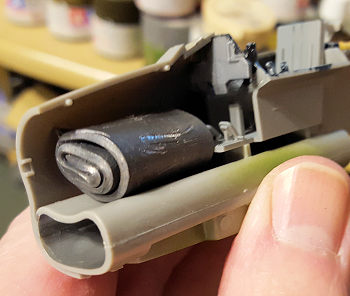 The
interior/intake assembly takes some fiddling around to get everything to fit
properly so take your time and it will finally get into place. I then rolled up
a length of lead weight and placed it atop the intake. This amount was more than
sufficient. Back when Terry Dean was
doing nose weights, he had one that fit right into the radome, but he is no
longer doing these, which is a shame. I then glued the other half of the
fuselage, after installing the fuselage NACA ducts, making sure all fit properly and left it to dry. As a note, you can
buy sheets of lead of various thicknesses on-line and a fairly small sheet will
last a very long time. I believe this is 1/16th inch thick. Once that was done,
the other fuselage half was attached and I did the usual seam work.
The
interior/intake assembly takes some fiddling around to get everything to fit
properly so take your time and it will finally get into place. I then rolled up
a length of lead weight and placed it atop the intake. This amount was more than
sufficient. Back when Terry Dean was
doing nose weights, he had one that fit right into the radome, but he is no
longer doing these, which is a shame. I then glued the other half of the
fuselage, after installing the fuselage NACA ducts, making sure all fit properly and left it to dry. As a note, you can
buy sheets of lead of various thicknesses on-line and a fairly small sheet will
last a very long time. I believe this is 1/16th inch thick. Once that was done,
the other fuselage half was attached and I did the usual seam work.
Then the wings were glued together after opening the holes in the lower wing for the drop tank. I then sprayed the center of the upper and lower wing with FS 16473, ADC grey as I've seen in photos and on the plane in the USAF Museum. When the grey had fully cured, I masked it and attached the slats. Then the wing was painted with Alclad II aluminum. The tail planes were glued in place, followed by the wings. I also sprayed the wheel and speedbrake wells with US interior green. These were later filled with Silly Putty as was exhaust section. The windscreen was masked as was the canopy, but the latter was left off. I used Silly Putty and tape to mask off the cockpit.
| COLORS & MARKINGS |
This was a good time to paint the airframe. I first painted
the radome black. This was masked off and Alclad II aluminum was sprayed onto
the bare plastic. It usually takes a couple of coats to get good coverage.
Fortunately, I buy the aluminum in 4 oz bottles otherwise I'd run out pretty
quickly considering all the aluminum planes I build. The fin tip was painted ADC
grey then masked and the center section repainted
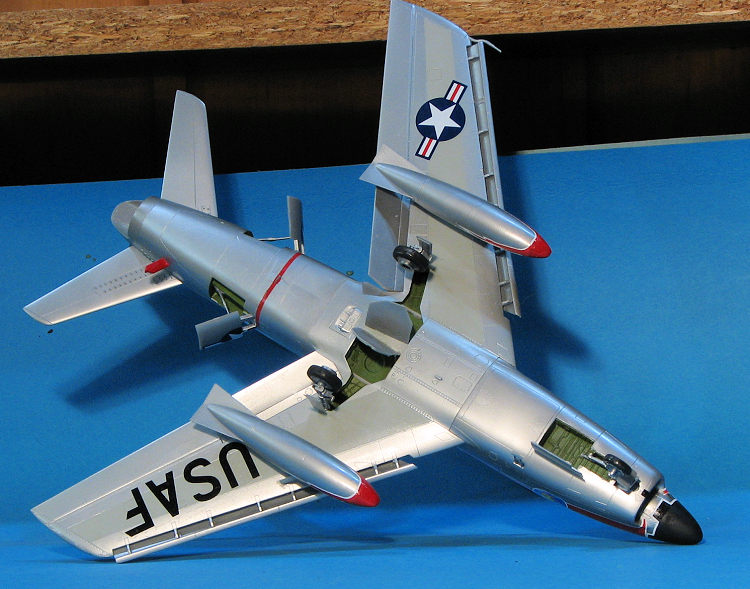 aluminum. I also painted the
area under the exhaust with dark aluminum. I used the kit wheels on this one,
painting the tires with Tamiya XF-85 then using the left over masking from the
Brassin set used on an earlier build to mask the tires so I could paint them
aluminum as well.
aluminum. I also painted the
area under the exhaust with dark aluminum. I used the kit wheels on this one,
painting the tires with Tamiya XF-85 then using the left over masking from the
Brassin set used on an earlier build to mask the tires so I could paint them
aluminum as well.
After all had dried overnight (Alclad II can be handled in 15 minutes after spraying, but I like to give it at least overnight so it cures), I removed the masking material and started installing the landing gear. When adding the little door retraction bits for the main gear, one of them disappeared into wherever kit parts go. I'll probably find it in a few months/years. When installing the doors, you should install the retraction pistons first. It makes it a whole lot easier. With the doors on, the wheels were attached. I could not find a photo of this plane or even this unit on the net so went with the early nose wheel.
Getting there. This was a good time to start applying decals. For this build, I chose another Superscale sheet: 48-772 for an early F-86D from the 469th FIS/359 FIG. This meant I had to paint the tips of the drop tanks in red 'to match the decals'. I used Tamiya X-7 for this after painting the tips in white. While this was going on, I started applying standard markings. I wasn't able to put on wing walk areas as I'd used those decals on a kit that came without a sheet. I like that Superscale includes the nose antiglare panel but why they included two sets of white radome marks is a poser.
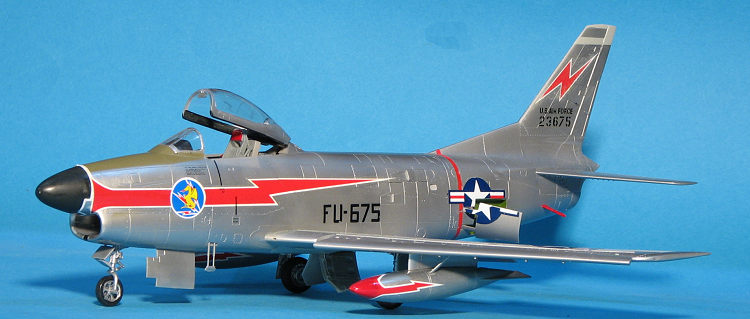 Application of the
Superscale decals brought to light that the decals
were horrible. By themselves they tended to break up. Coating them with
Microsoft decal film meant that they wouldn't conform using setting solutions.
Even after coating, some of them splintered on the edges. I especially had
issues with the drop tank decals as either they are too small or I applied them
too far back on the tank as they did not meet at either the top or bottom. Using
stripe decals to help out really wasn't the best option, but other than painting
the white stripes, there was little option. Usually even old Superscale sheets
work OK, but not this time. Even after they had dried, they flaked apart. So I
purchased another sheet, but it did the same thing, so this points to a poor
run. Eventually, I was able to recoat enough parts of the new sheet to replace
the ones that were the worse, though even then I had to apply them in a pool of
Future to get them to stick.
Application of the
Superscale decals brought to light that the decals
were horrible. By themselves they tended to break up. Coating them with
Microsoft decal film meant that they wouldn't conform using setting solutions.
Even after coating, some of them splintered on the edges. I especially had
issues with the drop tank decals as either they are too small or I applied them
too far back on the tank as they did not meet at either the top or bottom. Using
stripe decals to help out really wasn't the best option, but other than painting
the white stripes, there was little option. Usually even old Superscale sheets
work OK, but not this time. Even after they had dried, they flaked apart. So I
purchased another sheet, but it did the same thing, so this points to a poor
run. Eventually, I was able to recoat enough parts of the new sheet to replace
the ones that were the worse, though even then I had to apply them in a pool of
Future to get them to stick.
The rest of the build was pretty straight-forward and other than those pesky wing tank braces, the rest of parts fit without any real trauma.
| CONCLUSIONS |
I really like this kit and I will build another in the future. I would recommend that you do not buy Superscale 48-772 as it is obviously a defective print run. If you have not built this kit, then I suggest you give it a try. I think you will be pleased.
| REFERENCES |
https://en.wikipedia.org/wiki/North_American_F-86D_Sabre
February 2020
Copyright ModelingMadness.com. All rights reserved.
If you would like your product reviewed fairly and fairly
quickly, please
contact
the editor or see other details in the
Note to
Contributors. Back to the Main Page
Back to the Review Index Page
Back to the Previews Index Page